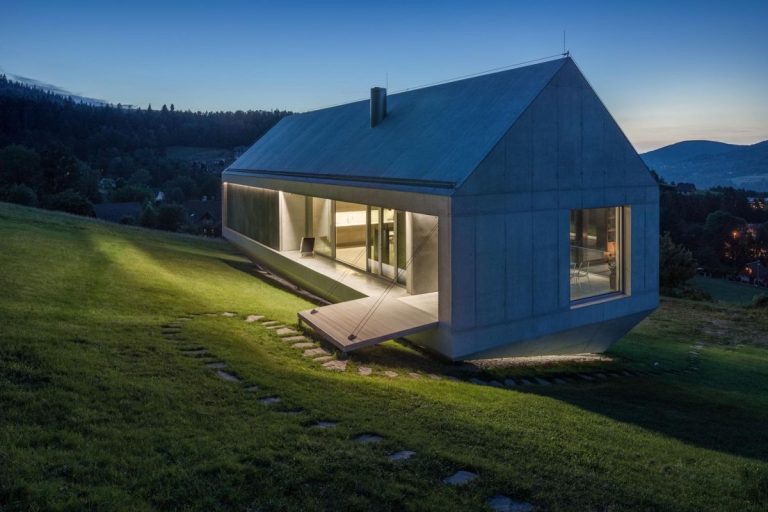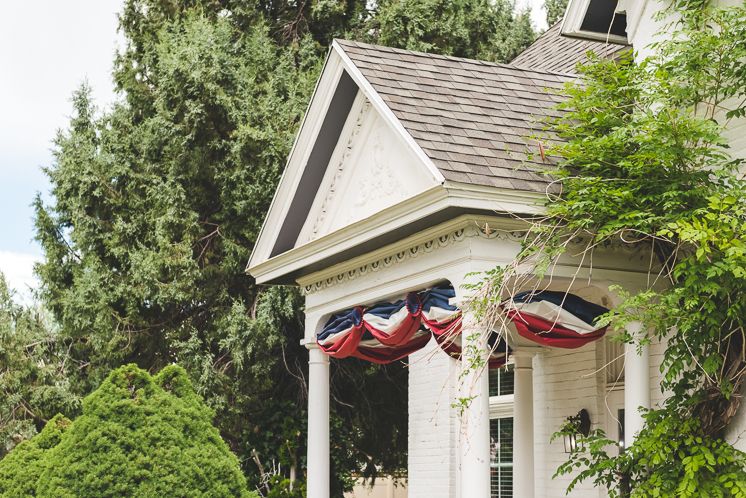The Most Popular Kitchen Tile Flooring Options Are Gorgeous and Durable
As one of the highest traffic areas of the house, the kitchen floor takes a big beating on a daily basis. From lots of foot traffic to spills, heat and moisture, the kitchen floor has to stand up to all of it and still look great. These are the reasons that kitchen floor tile is a really popular option for this space, thanks to its durability and the good-looking choices available across a range of prices. Just as with any other home surface, the different types of kitchen floor tile have positives and negatives that you’ll want to consider before plunking down your money. Here’s a roundup of the most popular types you’ll likely be considering.
Porcelain Tile Kitchen Flooring
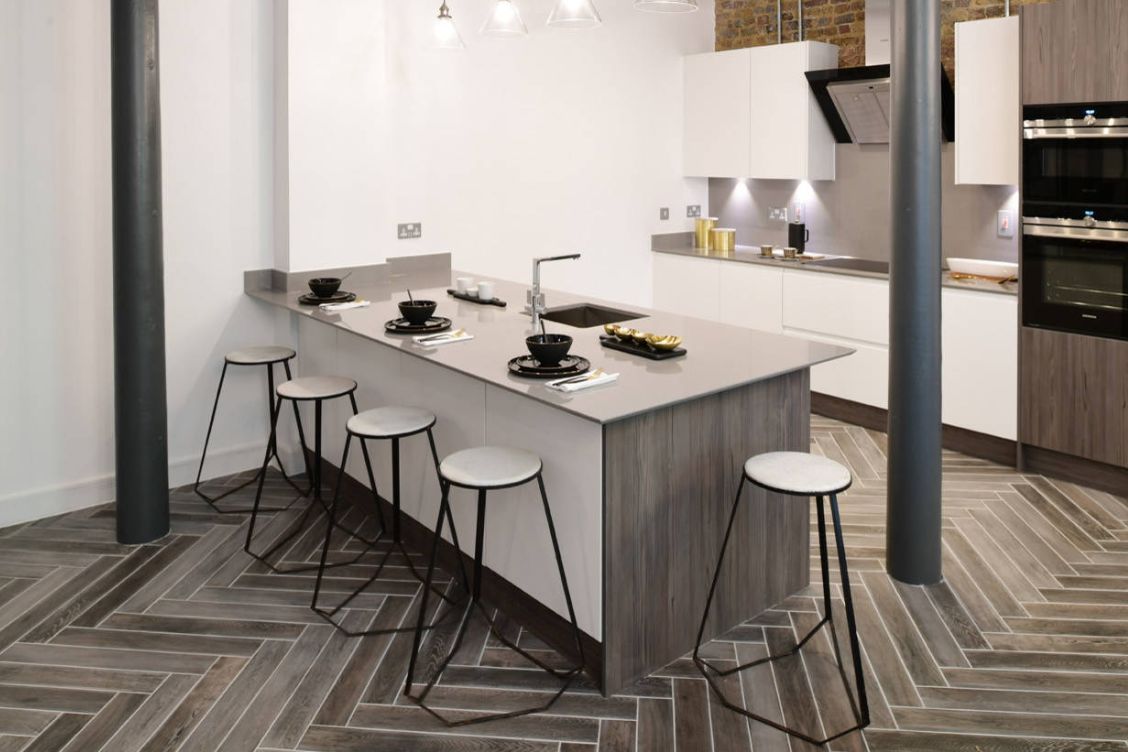
A step up from ceramic tiles, Porcelain flooring is made with a kind of clay that is denser. And, being fired at a temperature higher than regular ceramic, it is harder than granite and more durable, making it a great choice for kitchen flooring. This type of kitchen flooring is also really low maintenance, and the range of looks now available is unbelievable. Stone and wood styles are some of the newest innovations that can be more cost-effective. This one from Minoli in the UK has a stunning herringbone pattern that really looks just like wood with none of the maintenance. According to Home Advisor, part of porcelain’s durability comes from the fact that the color runs all the way through the tile and is not just applied to the surface. It’s so tough that it has been used in commercial settings. Moreover, this flooring will add value to your kitchen, not only from the perspective of appearance but also home value.
Lest porcelain sound like a slam dunk choice, there are a few points to remember before choosing it for your kitchen flooring. As with any tile floor, grout fills the spaces and must be very well sealed periodically otherwise it will be very difficult to keep clean. The second point to keep in mind is its weight. Porcelain tiles are very heavy and usually weight too much for an upstairs installation, especially if you plan on doing it yourself. Homeowners need to consult with professional installers about using it on upper levels because extra support might be needed. Finally, the cost of porcelain tile flooring is higher than the ceramic options not only because of the tile itself but also because of the installation.
Ceramic Tile Kitchen Flooring
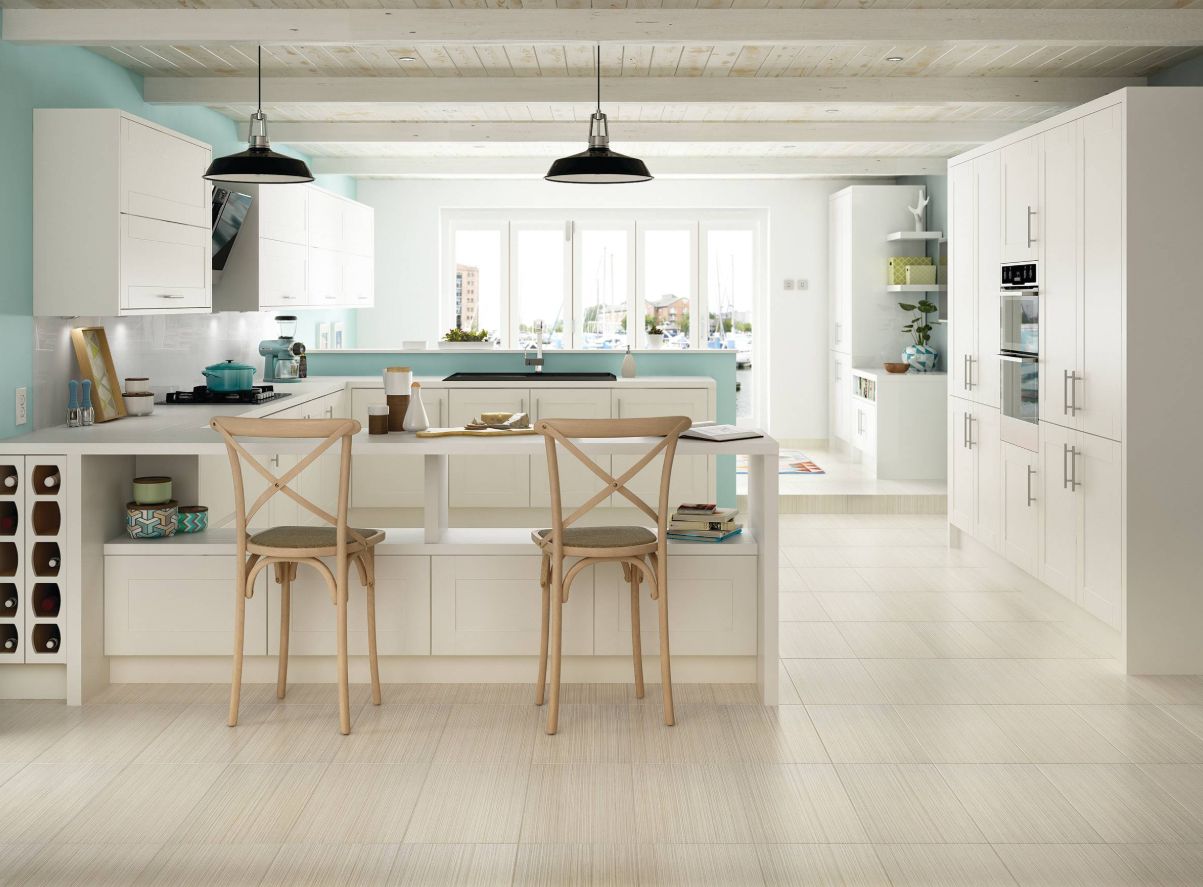
Related to porcelain tile, ceramic tile is also water and stain resistant, which are just some of the reasons it is one of the most popular types of kitchen floor tile. Nearly endless varieties of ceramic tile are available, both in glazed and unglazed types. in some types, the color is only in the glaze, while others are colored throughout. The size of the tiles also varies, from tiny mosaics to larger shapes, as in this floor, which is 12 x 24 Glazed Porcelain Floor Tile in Harmony Beige from The Masonry Center.
The durability of ceramic tiles is key, and, just like porcelain, repairs are easier because you can replace a tile or two and don’t have to redo the whole floor. In fact, ceramic is similar to porcelain in a number of ways, both positive and negative. On the downside, they are generally quite heavy and not always suitable for a second story installation. They can also be hard to stand on for long periods and feel cold in the winter, so kitchen mats may be necessary. On the positive side, ceramic tiles are generally cheaper than porcelain and affordable styles can be as low as $5 to $7 a square foot. Besides, ceramic tiles are also low maintenance, another reason for their popularity.
Travertine Tile Kitchen Flooring
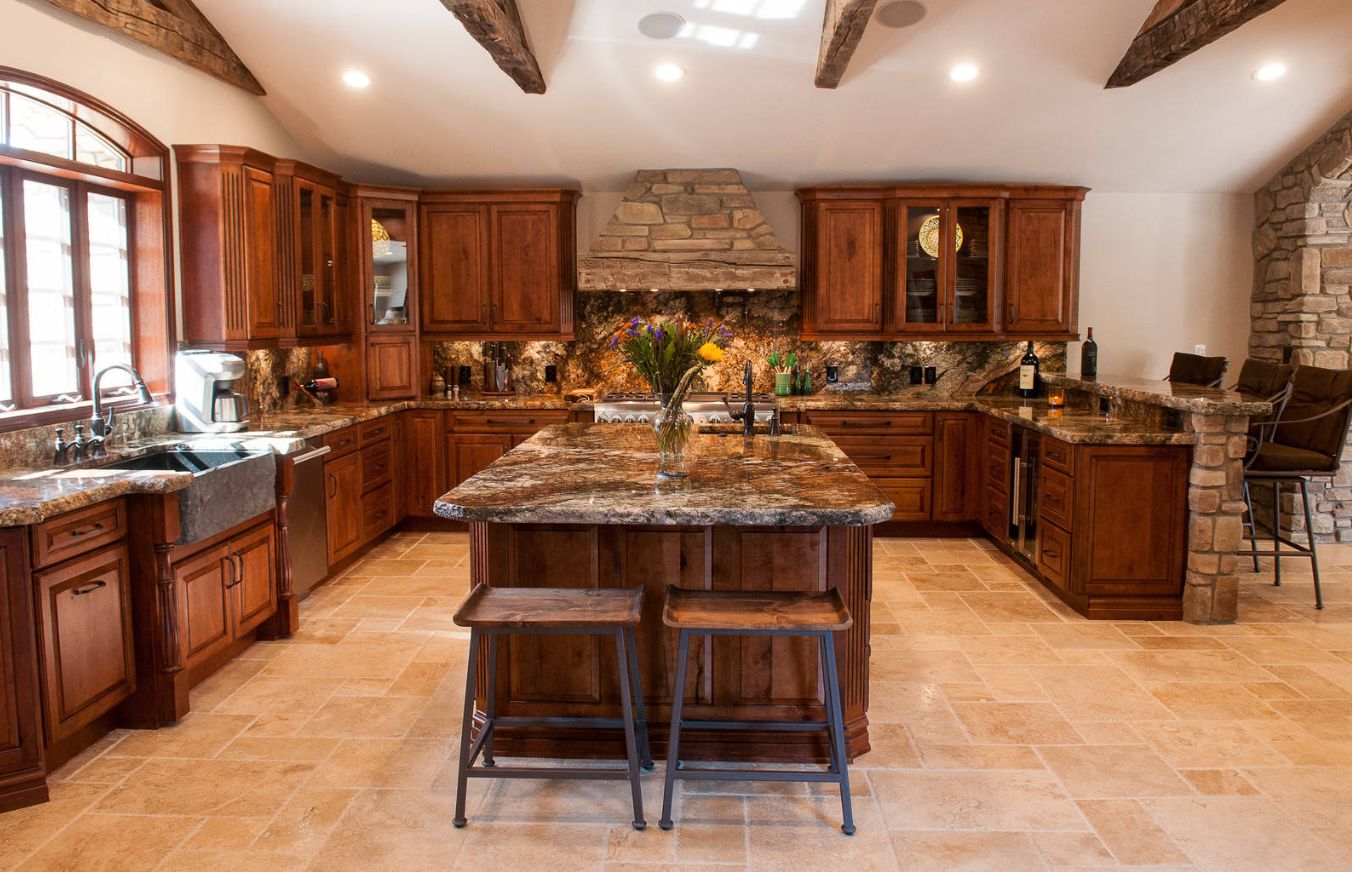
Fans of a natural look might be considering travertine for kitchen floor tile, which is becoming very popular. The appearance of this stone — actually a kind of limestone — is rustic, natural and earthy. Despite its low-key appeal, travertine can be found in plenty of luxury kitchens thanks to the varied and timeless look of the tile, like this kitchen floor by Geneau Granite and Tile. Homeowners love this tile because it’s durable and non-skid, as well as resistant to extreme temperatures. The cost of travertine kitchen floor tile is also not high, coming in much at levels less than other luxe options like marble.
A few things to keep in mind about travertine include the fact that it is more high-maintenance than other tile options because it is very porous and requires regular sealing. This is super important because natural stones can be damaged by etching or staining from certain styles of spills, especially those with acidic elements.
Slate Tile Kitchen Flooring
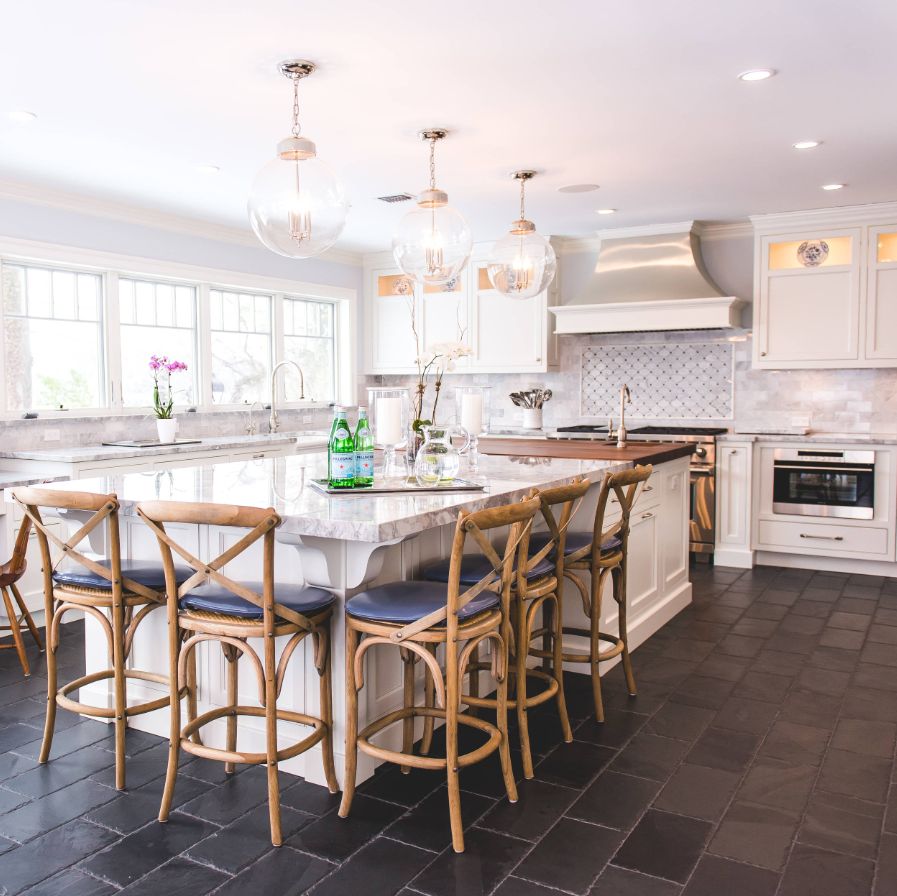
Another natural-looking option for kitchen floor tile is slate. This is an earthy choice because no two tiles look exactly the same. People love these natural stone tiles because they are so durable and resist scratching, chipping and cracking. This gorgeous kitchen by Katharine Jessica Interior Design shows the beautiful contrast between the white cabinetry and the slate floor.
Slate is found around the world and the stone is sliced into large slabs when it is mined from the earth. To make indoor installations easier, the back side of the stone is also smoothed out in a process called gauging. Of course, stains are more likely to show on these smoother tiles, and they are easier to scratch. Even though slate is durable, it too needs to be sealed on a regular basis to prolong the beauty and durability. Another potential negative is the initial cost of installation: The best slate tile suitable for the kitchen is expensive, so it is definitely a luxury kitchen floor tile option. That said, install slate in the kitchen and the resale value of the home will go up. For these reasons, as well as its exacting installation requirements, it is not meant for a do-it-yourself project.
Marble Tile Kitchen Flooring
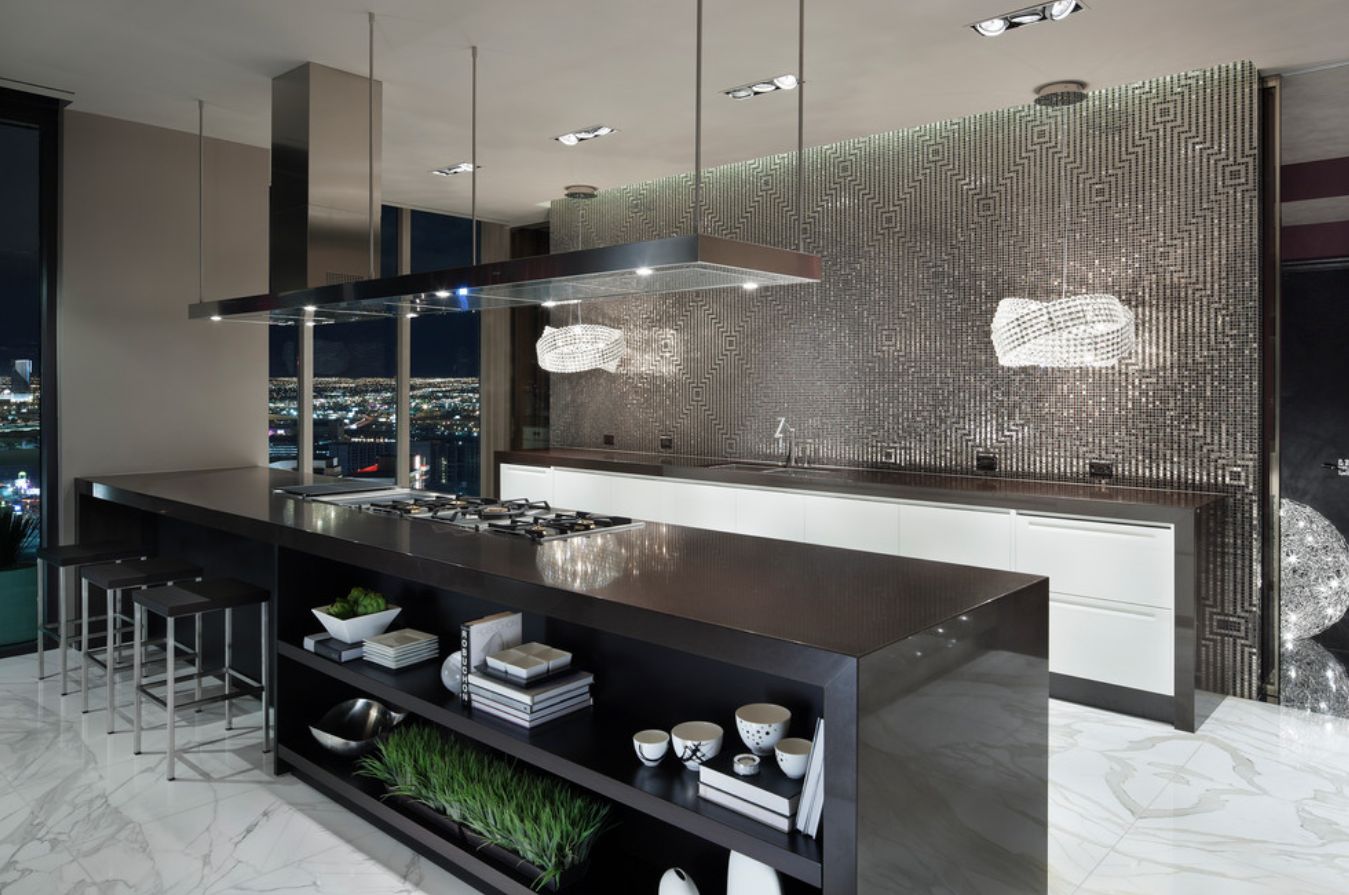
For an undeniably luxurious and classy looking kitchen, marble is the choice, hands down. It’s chic, highly polished and comes in a variety of colors that highlight its natural veining, as in this kitchen by Earth Elements. Naturally translucent, marble seems to have a luminous glow in the sunlight, which unlocks its innate radiance. And, because marble is a natural stone, no two tiles are the same, making each individual floor unique. Moreover, natural stone like marble can be more eco-friendly because no chemicals are used to make it.
Of course, just because it is one of the top luxury flooring materials doesn’t mean that it is fuss-free. While it is extremely durable thanks to its high density, it has to be maintained properly to prevent scratching and staining. Sealing it is critical because marble reacts strongly to acids and spills must be cleaned up immediately. This is important for safety too because marble can be super slippery when wet. Last but not least, marble is a very expensive flooring tile — higher than other natural stone options — so professional installation is a must.
Cement Tile Kitchen Flooring
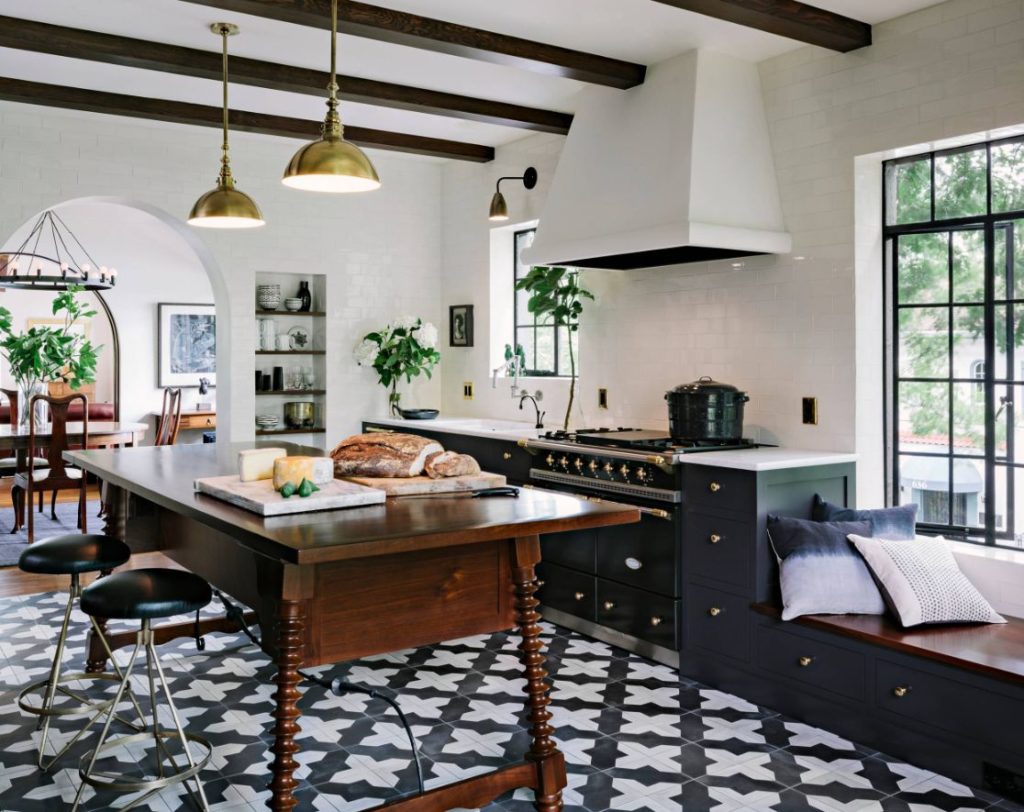
Cement kitchen tile flooring is at the top of the trend list these days. It hasn’t been that common but is gaining in popularity thanks to all design options as well as the overall look that works even in minimalist kitchens. A gorgeous gray and white pattern by Grenada Tile is a fabulous example. Cement tile has a more refined look than poured concrete and is more adaptable when it comes to style. These tiles are eco-friendly because they’re made from natural materials and are not fired in a kiln.
Some of the features of cement tile can be drawbacks. According to The New York Times, unlike ceramic tile whose glazed surface is “impervious after being fired at a high temperature in a kiln. Cement tile is cured at room temperature, not fired, and the colored layer on top, usually about an eighth of an inch thick, is porous.” They’re thicker than standard tile and that also makes them heavier. Moreover, the porous nature of these tiles makes them easy to stain and scratch, meaning that regular resealing is a must. Cost wise, cement floor tiles are more expensive and require professional installation, which isn’t cheap either. Some designers say that slight chips and scratches, as well as the “patina” that cement tiles acquire over time, are beautiful and natural, but you have to be sure that you’re ok with these features before investing in this type of flooring.
Cork Tile Kitchen Flooring
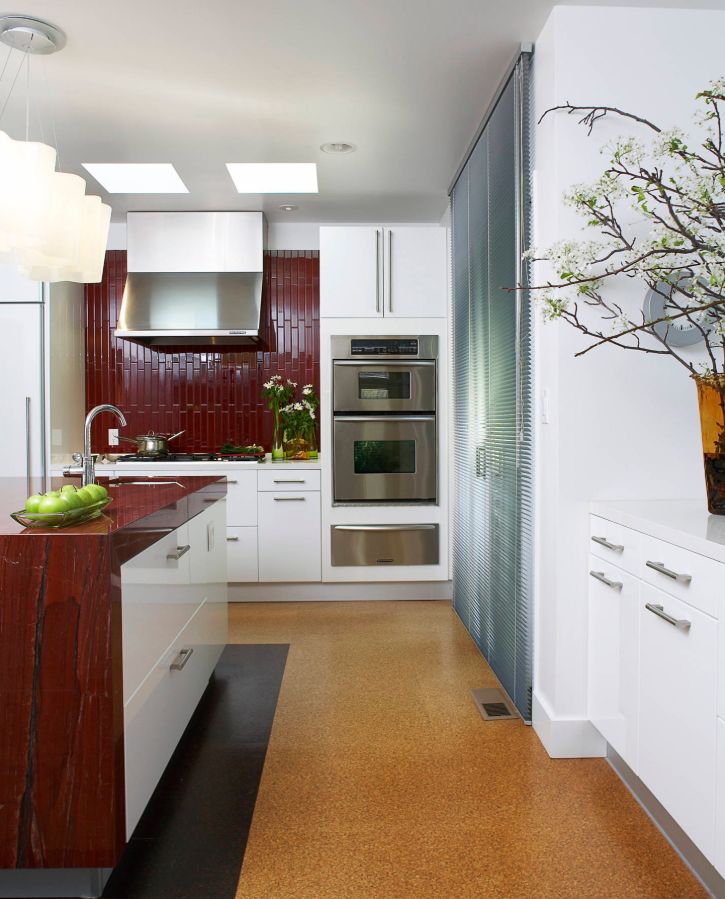
Perhaps a more unusual choice for kitchen floor tiles, cork tiles have plenty of advantages over other flooring tiles, especially the warm, soft look that they bring to a space. Pamela Pennington Studio’s kitchen shown here has a cork floor and is quite sleek, yet warm and welcoming. One of the top reasons people choose cork tiles is the pleasant feeling that they have underfoot. Soft and warm, they are easier on the feet than other, harder tile surfaces. Cork’s natural properties also make it a great insulator for temperature as well as sound, absorbing a lot of noise.
As with any kitchen floor tiles, there are also drawbacks to cork kitchen tile floors. The same features that make it so pleasant to walk on the same ones that make it less durable. It can be scratched or dented, and standing water can damage the tiles, although proper sealing and maintenance will help keep water stains at bay. With regard to cost, cork tiles are comparable to other flooring like ceramic tile 0r hardwood.
Hardwood Flooring
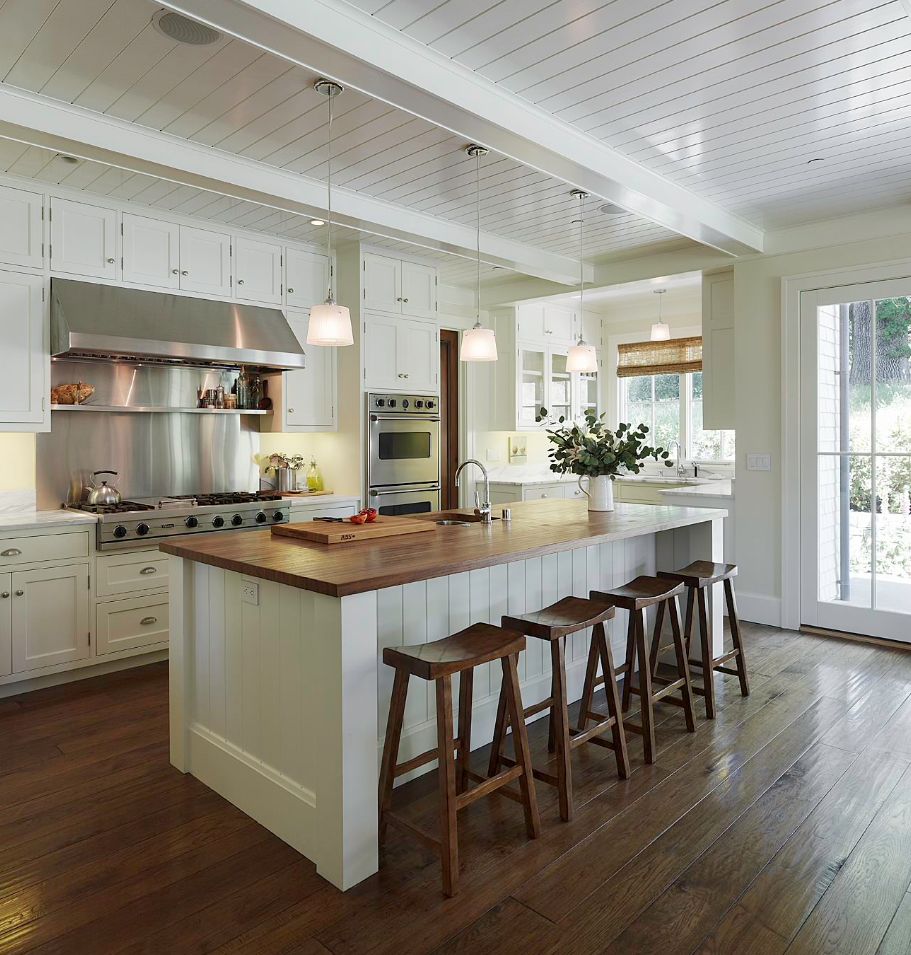
Sought after by home buyers everywhere, hardwood floors in the kitchen — and throughout the house — are a big plus in many ways, not least in how they look. The warmth of the wood grain is a major reason and the range of colors and styles available today is a far cry from the just a decade ago. Plank widths also vary, with current preferences trending toward wider types, as in this kitchen by Taylor Lombardo Architects. This type of kitchen flooring is super versatile and works with every style of interior decor. With regard to cost, hardwood is more expensive because professional installation is required, but new engineered types of hardwood flooring offer the same look at a slightly lower price.
Hardwood is quite durable…just check out historic homes that are a century old or more. That said, they can be dented or scratched rather easily and requires more maintenance than tile flooring. One of the most damaging things for a hardwood floor is water, so while it is water resistant, spills should be cleaned up right away. Kitchen leaks or flooding can cause damage that would mean replacing the floor. On a weekly basis, regular sweeping and mopping is all that’s needed, however, hardwood flooring should be sanded and refinished every decade or so and that is not an easy or inexpensive task.
The post The Most Popular Kitchen Tile Flooring Options Are Gorgeous and Durable appeared first on Home Decorating Trends – Homedit.

